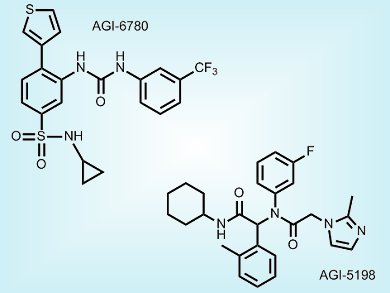Isocitrate dehydrogenases (IDH) 1 and 2 are metabolic enzymes converting isocitrate to α-ketoglutarate. When mutated in their catalytic site, however, they reduce α-ketoglutarate to (R)-2-hydroxyglutarate, a tumorigenic metabolite. Consequently, mutant IDH1 promotes the growth of brain tumors (gliomas) and mutant IDH2 favors the development of blood cancers (acute myeloid leukemias).
Two American teams discovered novel small molecules that inhibit these mutant enzymes. Fang Wang, Agios Pharmaceuticals, Cambridge, MA, and colleagues developed AGI-6780, a heterocyclic urea sulfonamide that binds to mutant IDH2 in a unique allosteric site, thereby potently and selectively blocking its catalytic activity and the growth of leukemic cells. Similarly, Dan Rohle, Memorial Sloan-Kettering Cancer Center, New York, and co-workers identified AGI-5198, a compound which inhibits mutant IDH1 and suppresses gliomas growth without exerting toxic effects on healthy tissues.
The therapy of gliomas and acute myeloid leukemias might, therefore, benefit from the use of these new molecules.
- An Inhibitor of Mutant IDH1 Delays Growth and Promotes Differentiation of Glioma Cells,
D. Rohle, J. Popovici-Muller, et al.,
Science 2013, 340 (6132), 626–630.
DOI: 10.1126/science.1236062 - Targeted Inhibition of Mutant IDH2 in Leukemia Cells Induces Cellular Differentiation,
F. Wang, J. Travins, et al.,
Science 2013, 340 (6132), 622–626.
DOI: 10.1126/science.1234769




